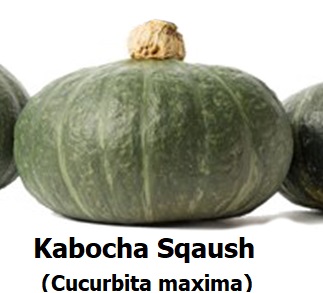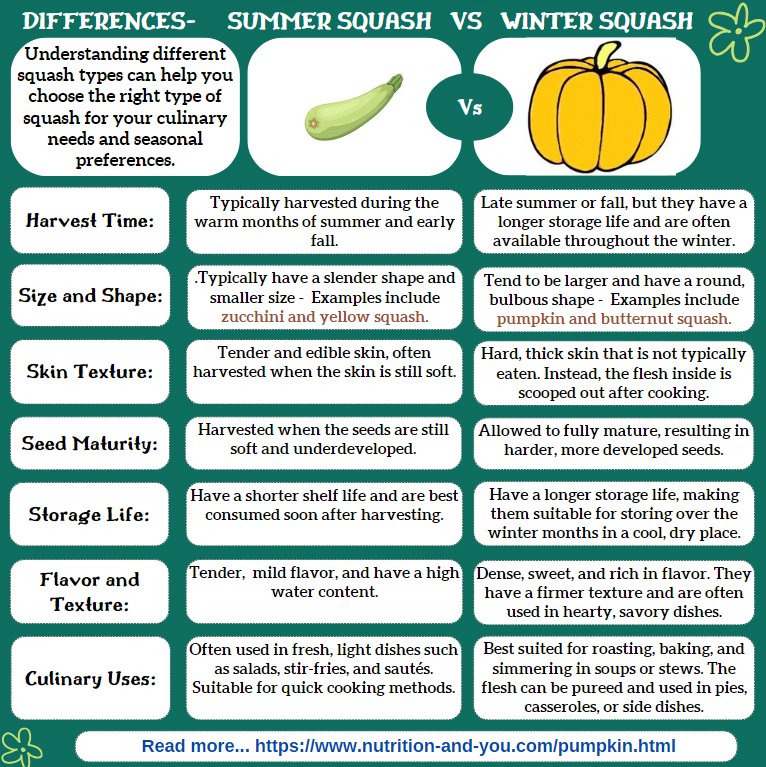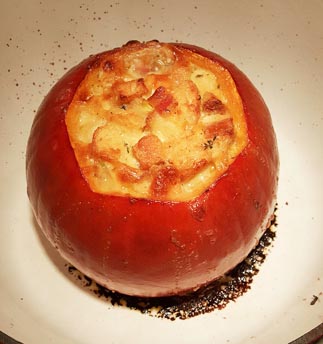Kabocha Squash Nutrition facts
Kabocha squash is a Japanese winter squash variety in the Cucurbita maxima subfamily. This deliciously sweet, orange-fleshed winter squash has long storage qualities.
Kabocha squash was originally introduced to Japan by Portuguese sailors in the 16th century. Kabocha is a generic term for winter squash in Japan, whereas, in the U.S, it is a specific type of winter squash like hubbard, butternut, pumpkin, etc.
Japan has the highest consumption of Kabocha squash in the world.
Botanical name: Cucurbita maxima.
 |
Kabocha prefers moist, fertile, well-drained sandy soils and little or no shade. Seedling is done by late May or early June, usually when there is no longer a danger of frost. The plant is monoecious, and bears separate male and female flowers.
The fruit appears about 60 days after the seedling and is ready for harvest at 90 to 100 days. The fruit is ovate (horizontally oval), vertically grooved skin, with dark green, jade-green, blue-gray, or bright red-orange rinds.
Their dense, starchy, grainy, orange-yellow flesh often has the consistency, flavor, and sweetness of water chestnuts or sweet potatoes. Inside, a central hollow space is filled with numerous, large, flat seeds.
Kabocha weighs from 1.5 to 4 pounds.
Harvesting
Like all winter squash varieties, kabocha can be harvested after it matures completely. It can be stored for several months, unlike the summer squashes, which are harvested early and have a short shelf-life.
The timing for harvesting is considered when the entire foliage becomes senesced, and the stem turns corky, brown, and hard, which is usually about 45 days after the flowering.
The fruits are then kept in warm weather to cure for 1-2 weeks before storing in a cool, dry place.
Some of the popular varieties are:
Green kabocha- 'Sweet Mama'.
Gray kabocha- 'Winter Sweet'
Red kabocha- 'Sunshine'.
See the differences between Summer and Winter variety squashes in an infographic:
 |
Health benefits of Kabocha squash
Kabocha is a calories winter squash that holds just 34 calories per 3.5 oz (100 g).
It is also an excellent source of soluble and insoluble dietary fiber. Besides, it carries no saturated fats or cholesterol.
Kabocha squash is a gluten-free food item. It can be a good substitute for gluten-sensitive (celiac disease) people.
Kabocha squash is a powerhouse of carotenoids and vitamin A, and provides about 1370 IU per 3.5 oz (100 g) and 820 μg of β-carotene. Vitamin A is an important antioxidant that helps in cell growth and mucosal repair, fighting cancer, and for good vision.
Together with vitamin-A, these poly-phenolic pigment compounds help scavenge harmful oxygen-derived free radicals and reactive oxygen species (ROS) from the body that play a role in cancers, aging, and various inflammatory disease conditions.
Fresh kabocha squash holds relatively higher amounts of vitamin C (20% of RDA /3.5 oz), pyridoxine, and thiamin than pumpkin. Vitamin C is essential for collagen synthesis in bones, cartilage, and blood vessels, and aids in iron absorption.
It is also a good source of folic acid and provides 24 µg or 6% of RDA per 3.5 oz. Folate is a cofactor involved in cell division and DNA synthesis. It helps prevent neural tube defects in the newborn when taken during early pregnancy in expectant mothers.
Kabocha is low sodium (3 mg/100 g) winter squash. On the contrary, it carries ample amounts of potassium (350 mg/100 g), an important intra-cellular electrolyte. Potassium is a heart-friendly electrolyte, which helps in decreasing blood pressure and heart rate by countering the pressing effects of sodium.
Moreover, kabocha squash carries good amounts of other B-complex groups of vitamins like pyridoxine, thiamin, pantothenic acid, riboflavin, and minerals like copper, selenium, calcium, iron, manganese, phosphorus, and zinc.
| Principle | Nutrient Value | Percent of RDA |
|---|---|---|
| Energy | 34 Kcal | 1.7% |
| Carbohydrates | 8.59 g | 6.6% |
| Protein | 0.95 g | 1.7% |
| Total Fat | 0.13 g | <1% |
| Cholesterol | 0 mg | 0% |
| Dietary Fiber | 1.5 g | 4% |
| Vitamins | ||
| Folates | 24 μg | 6% |
| Niacin | 0.500 mg | 3% |
| Pantothenic acid | 0.188 mg | 4% |
| Pyridoxine | 0.156 mg | 12% |
| Riboflavin | 0.062 mg | 5% |
| Thiamin | 0.030 mg | 2.5% |
| Vitamin-A | 1370 IU | 45.5% |
| Vitamin-C | 12.3 mg | 20.5% |
| Electrolytes | ||
| Sodium | 4 mg | <0.5% |
| Potassium | 350 mg | 7% |
| Minerals | ||
| Calcium | 28 mg | 3% |
| Iron | 0.58 mg | 7% |
| Magnesium | 14 mg | 3.5% |
| Manganese | 0.163 mg | 6% |
| Phosphorus | 23 mg | 3% |
| Selenium | 0.4 µg | <1% |
| Zinc | 0.21 mg | 2% |
| Phyto-nutrients | ||
| Carotene-ß | 820 μg | -- |
| Crypto-xanthin-ß | 0 μg | -- |
| Lutein-zeaxanthin | 38 μg | -- |
Selection and storage
Kabocha squash, being a winter or hard squash type, is grown in the warm season and can be stored for 3-4 months (through the winter).
Kabocha squash is available from October to January in the farmer's markets. Choose average-sized fruits featuring dry and intact stems. Avoid those with blemished/soft/rotted stems, damaged, cuts/punctured, etc.
At home, Kabocha keeps for 2 to 4 months or more if stored in a cool, dry, and dark place.
Cut sections, however, should be used in the cooking early. If you choose to keep it for extended use (up to 1-2 days only), then place it inside a plastic wrap in the refrigerator set at high relative humidity.
Preparation and serving methods
Kabocha squash is a popular winter vegetable in the U.S., Japan, and Canada. It can be used in any recipe calling for butternut squash or pumpkin.
Kabocha are known for their dry-textured flesh, which holds their shape in whole baked, stuffed, stews and curries. It is best suited for baking, roasting, steaming, stuffing, boiling, and sautéing.
Its rind is tough, and although edible, some chefs prefer to peel it before consumption.
It can also be sliced into rings or cubes and used in an endless array of recipes such as soups, salads, stews, gratins, sandwiches, and risotto.
 |
| Suffed Kabocha. Stuffing includes bread, bacon, sausage, onion, celery, and herbs. Courtesy: Tim Evanson. |
Here are some serving tips:
Kabocha is a popular vegetable in Japan, used in soups, sushi, and tempura dishes.
Raw kabocha is used grated into a winter salad, which adds a sweet crunch and burst of orange color.
Cut Kabocha in halves, scoop off seeds, and stuff with bread, grains, bacon, meat, cheese, mushrooms, and leafy greens and herbs, and bake in the oven.
Enjoy kabocha squash gratin with complementing vegetables, or sausage.
Mashed/pureed Kabocha is a healthy alternative to mashed potato.
Baked and pureed or mashed kabocha flesh can be used as a filling for empanadas, enchiladas, and ravioli, or used in desserts, pies, puddings, and bread.
Kabocha squash makes a delicious creamy soup.
Kabocha squash kernels can be eaten as a snack. Simply toast the seeds in the oven and enjoy!
Safety profile
Allergic reactions to kabocha squash are rare. Pregnant women and infants can safely enjoy it. (Medical disclaimer).
You may also like to read ≻≻-
≻≻- Spaghetti squash nutrition facts.
≻≻- Acorn squash nutrition facts.
≻≻- Delicata squash nutrition facts.
≻≻-Pattypan squash nutrition facts.
≻≻-Back to Vegetables from Kabocha Squash nutrition. Visit here for an impressive list of vegetables with complete illustrations of their nutrition facts and health benefits.
≻≻-Back to Home page.
Further reading:
Kabocha and Buttercup Squash for Western Oregon Gardens- Oregon State University Extension Service.
Watch your garden grow- University of Illinois Extension (PDF).